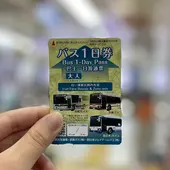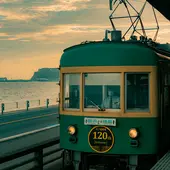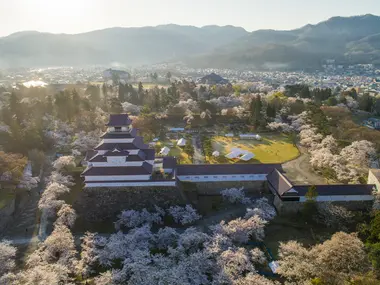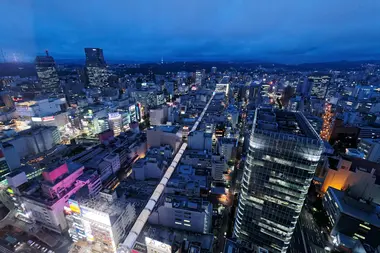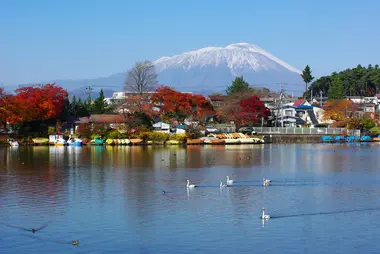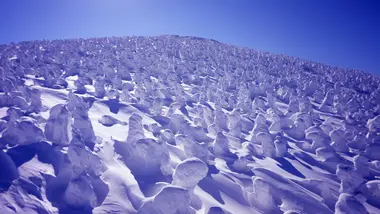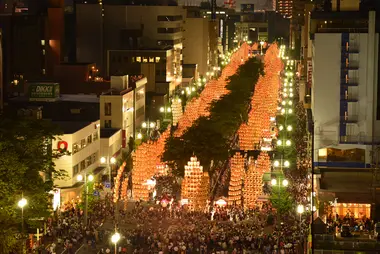Regional Rail Passes in Tohoku & East Japan
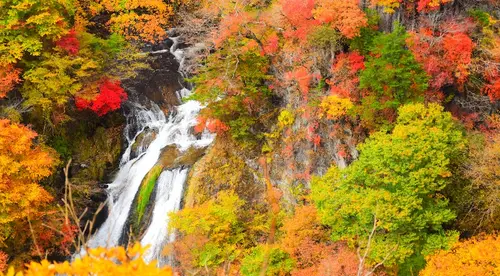
Between Japan's capital, Tokyo, and the northernmost island of Hokkaido, the regions of Tohoku and East Japan hold many of the country's most beautiful prefectures, sights and landscapes! Featuring a rich traditional arts & crafts culture, as well as many local delicacies, Tohoku is a region best explored by train, thanks to the different regional passes available!
The treasures of Northern Japan: Explore Tohoku with a regional pass!
Although often overlooked by travelers, the Tohoku region in the north of Honshu features chiseled coastlines and mountain ranges from Tokyo to Aomori, the main island's northernmost city. The largest city in the Tohoku region is Sendai, a cosmopolitan capital with plenty of charm. Not far from the city of Sendai is Matsushima, one of the "Three Views" of Japan, where travelers can admire the reflection of a pine tree forest in the clear crystal waters of the sea. The mountainous central region features plenty of hot springs and fantastic natural scenery.
How to buy a Regional Pass for Tohoku and East Japan
As a day-trip from Tokyo, explore Nikko, with its temples and shrines surrounded by cedar trees, and stroll by its river and sacred bridge. In Karuizawa, there is plenty of shopping to be done while awaiting your train to Gala-Yuzawa ski resort.
There is so much to explore in the Tohoku region.
Fukushima & Miyagi
Heading up north the island of Honshu, the first prefecture in the Tohoku Region will be Fukushima. This is a prefecture often dubbed as "the fruit kingdom" of Japan due to its opulent bounty of domestically cultivated fruits, with apples, grapes, melons, and kumquats in particular being highly sought after. The rich soils and beautiful climate of Fukushima contribute to this, while also being a marvel to look at! Through each season, Fukushima offers amazing scenery and spots like Mount Shinobu and the Natsuigawa Vallery will be ideal for seeing it firsthand! In Aizuwakamtsu, Tsuruga Castle is one of the most venerable castles in the entire country, a favorite among travelers and locals alike!
Miyagi Prefecture borders Fukushima to the north. Its largest city is Sendai, well-known for its vibrant atmosphere and amazing food scene. Its claim to fame is ox tongue, thick-cut and char grilled and served with barley rice. Also famous in Miyagi is sake and whiskey! Fans of Japanese whiskey ought to definitely check out the Nikka Whiskey Distillery in Miyagikyo. A full tour of the facility plus exclusive products are all available! Miyagi Prefecture is also a great spot to relax with Naruko Onsen being a beautiful spot with amazing natural hot springs.
Iwate and Aomori
Proceed further north up Tohoku into Iwate to discover one of the geographically largest prefectures in Japan. Iwate is largely notable for its long coasts, which are host to amazing seaside views and delicious seafood! Shellfish and uni (sea urchin) can often be found on the menu, hand-picked by traditional ama divers on the beaches. Iwate's capital, Morioka, was listed as one of the New York Times must-visit locations in 2023, notable for its modest yet discovery-filled streets and delicious food! Visitors cannot miss trying the three great noodle dishes of Morioka as well as a hike up Mount Iwate that looks over the city.
Aomori is the northernmost prefecture on Honshu Island, right below Hokkaido with the Tsugaru Strait in between the two. Aomori is synonymous with its iconic summertime festival, Nebuta, widely known for its intricate and colorful paper floats that are illuminated and paraded around the city at night. The festivities for Nebuta go on for almost a full week from the end of July to the beginning of August, truly making it a staple of Aomori! The prefecture is also notable for seafood, much like other places in Tohoku, especially for maguro tuna from the town of Oma right by the Tsugaru Strait. Hirosaki Castle is another notable place to visit in Aomori, a beautiful view with an iconic bright crimson bridge at the foot of the traditional Japanese structure!
Yamagata and Akita
Loop back down south from Aomori Prefecture, down the Japan Sea Coast of Honshu Island, and you'll arrive at Yamagata Prefecture! For many, the first thing that comes to mind with Yamagata Prefecture is winter. Zao Onsen combines two of the best colder month activities: relaxing in hot springs and winter sports! The slopes of the mountains by Zao Onsen are world-renowned by skiiers and snowboarders, and the snow-covered trees that line the descent, known as the "snow monsters," are famous as well! Another famous onsen spot in Yamagata is Ginzan Onsen! During winter, especially, when the tall, traditional style buildings have stark white snow on top of them, the atmosphere must be experienced first-hand to believe!
Akita Prefecture is largely known for its famous Kanto Festival in summer, where tall, handheld floats are paraded down the roads of Akita City with lanterns hanging from them. Parade participants will do tricks with the floats, holding them with one hand, from the belts of their traditional garb, and even from their foreheads for the super experienced! The floats illuminate the city streets at night, making it an iconic event for the city.
Also in Akita is Lake Tazawa, famous for its bright crimson torii gate on the coast that is especially beautiful in winter. With stark white snow around it, it's reminscent of the Japanese flag to a point, representing the nation's two national colors of red and white.
Cultural treasures near major cities: Check out regional pass options for exploring East Japan!
For many, Tokyo will be the central point of exploration when coming to Japan. But easily accessible thanks to the area's efficient rail system are a number of great destinations that harbor treasures that many may overlook! Take a look at some fo the regional pass options for East Japan and start exploring some of the country's most beloved destinations, from ancient capitals to nature-rich getaways!
Nagano and Niigata
Nagano and Niigata are two prefectures with geography largely defined by the Japanese Alps, a lush mountain range cutting through the main island of Honshu. Nagano is one of the few prefectures in the archipelago of Japan that is fully landlocked with no coasts, but has gorgeous mountains, roaring valleys, and rushing rivers to make up for it. The capital city, also named Nagano, was host to the 1998 Winter Olympics and has a museum commemorating the games. Nagano City is also home to one of the most storied temples in all of Japan, Zenko-ji Temple, a must-visit for those interested in history. A bit outside of Nagano City, Jigokudani Snow Monkey Park is a standout attraction, home to a curious troupe of Japanese Macaques that utilize the local hot springs to stay warm during winter!
Niigata is blessed with a very long coast on the Japan Sea side of the island, meaning delicious seafood and beautiful scenery! Itoigawa has a stand out beach famous for its natural jade rocks that can be searched for and collected. Off the coast of Niigata, Sado Island is a unique destination, rich in forests, nature, and beautiful waters. Also on the island are a number of esteemed sake breweries that offer tastings and tours!
In fact, Niigata is well-renowned for sake, largely due to its nutritious rice crop that benefits from the prefecture's long winters and rich soils. Niigata visitors also ought to see Kiyotsu Gorge, one of the Three Great Canyons of Japan alongside Kurobe Gorge in Toyama and Osugi Valley in Mie Prefecture.
Why get a regional pass?
Those visiting Japan have undoubtedly heard about the rail pass options available for traveling around Japan via train. As opposed to getting individual tickets, regional and Japan Rail Pass options allow for unlimited rides on certain train lines, removing the need for strict itineraries and planning and oftentimes saving holders money on their commuting expenses. The most wide-ranging and popular option for these passes is the National Japan Rail Pass, which allows for unlimited rides on Japan Railway-operated train lines throughout the country. This includes high-speed Shinkansen bullet trains as well as many express trains and local lines within cities.
However, for those who are concentrating their travels primarily in one region or location, regional pass options also offer great value and convenience! Many of these regional passes operate in the same way as the National Japan Rail Pass, however, they incorporate public transportation options in a designated area. There are regional passes for many locations throughout Japan, such as Kansai, Hakone, Kyushu, Shikoku, Tohoku, and more! Depending on your itinerary and what you plan to see, a regional pass may be best for you, for stress-free, all-encompassing transit to and throughout your favorite destinations in Japan!
Why book your regional pass with Japan Experience?
Frequently Asked Questions about Regional Rail Passes


